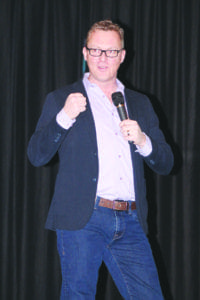Kenneth Brown
of The Crossroads
National best-selling author Doug Griffiths (13 Ways to Kill Your Community) has delivered his message to an eager audience at an event in Kindersley.
Griffiths, who was raised on a ranch at Coronation, Alta., gave his presentation to a packed room on Nov. 21 at the Norman Ritchie Community Centre. The author also visited Kindersley Composite School earlier in the day to give a special presentation to students.

Author Doug Griffiths, a former teacher and politician, gives a presentation to a packed room of folks on Nov. 21 at the Norman Ritchie Community Centre in Kindersley. The 13 Ways to Kill Your Community author spoke for nearly two hours.
There were high school students from Kindersley, Eatonia and Marengo. The event was presented by Community Futures Meridian Region and the Kindersley District Chamber of Commerce. The author spoke for nearly two hours at the community centre.
[emember_protected for=”2″ custom_msg=’For more on this story, please see this week’s print edition of The Cross Roads.’]
The room was mostly filled with people from area municipalities and businesses. A select group of people also had the opportunity to enjoy an intimate experience with Griffiths at the Canalta Hotel Kindersley. People had a chance to ask the author questions before they ate supper.
Rick Miller, a director for the chamber of commerce, delivered a welcome and opening messages before the presentation. Miller said he wanted to thank all of the people and groups that bought tables in support of the event.
Vickie Newmeyer, the region’s Community Futures general manager, also addressed the audience before the presentation. She said it was a real pleasure working with the chamber to bring the best-selling author to Kindersley. Newmeyer thanked all of the area’s municipalities that supported the event.
Griffiths started his presentation by telling people more about his background. He was born and raised near the small community in Alberta and he said he grew up thinking he had three options for what he could do in life.
He told people the three options were working in the oil patch, taking over the family farm or going to university. He got a degree in philosophy at the University of Saskatchewan and did not go to law school as originally planned. With a degree in philosophy, he said he figured he would end up back at the farm feeding cows.
Griffiths said he instead went back to school to get a teaching degree. He taught school for a while, and then he said it dawned on him that communities all over were dying.
He decided to enter politics, and it was the beginning of a journey that led to him writing “13 Ways to Kill Your Community.”
He noted that he was the MLA for Battle River-Wainwright for 13 years and he once ran for the leadership of the Progressive Conservative Party of Alberta, a race won by Alison Redford. In his time as MLA, he held several cabinet positions.
Griffiths told the story about how he travelled across Alberta, and he visited 200 of the more than 400 communities in the province. He spoke to community members, and then he wrote a rural development strategy that received praise from the province’s premier at the time.
The author, who is the president and CEO of 13 Ways Inc., now spends time travelling to communities across North America to help them develop their own strategies. He said he believes community building is the most important job a person could do.
“We need to make sure that we stop sabotaging our success,” Griffiths told his audience, recognizing that all communities have plans and communities end up needing plans to manage the plans because there is a lot going on.
Griffiths said people have similar problems by getting bogged down in their busy lives, but a positive attitude will help. He noted that it is all about attitude for communities, too, and not necessarily about infrastructure and people. The attitude of a community could make all the difference, he stressed.
The author’s presentation, in essence, was a chapter-by-chapter overview of his best-selling book. He introduced the topics of all 13 chapters and bolstered his messages with personal accounts and stories from his travels and experiences.
He said the point of the topics is not to point fingers at each other because all communities do things to sabotage their success, but the point is to stop doing those things. He then started with the first chapter titled Forget the Water – Quality and Quantity.
Griffiths used the example of how Flint, Mich., wanted to distance itself from a relationship with Detroit, so the city turned on its old water system that had led pipes and it ended up causing led poisoning in babies. The situation has also resulted in lawsuits and he said if you want to kill your community, forget about safe, clean drinking water.
The author always opened with the title of a chapter, provided stories to prove his points, and ended with a comical or stern comment to reiterate his messages before moving on to the next topic. He delivered his messages with passion and energy.
He continued to go through the chapters of his book. The other 12 ways to kill your community are don’t attract businesses, don’t engage youth, deceive yourself, shop elsewhere, don’t paint, live in the past, shut out your seniors, reject everything new, ignore outsiders, grow complacent and don’t take responsibility.
The chapter titled “Don’t Paint” focused on drawing people to a community through beatification projects such as having attractive buildings. He spoke about how two communities located near each other had fought each other to attract businesses in the past and neither community ended up with the businesses. He said co-operation within a community is important, but so is co-operation among communities.
He noted that the chapter titled Ignore Outsiders focuses on welcoming new residents both foreign and domestic and if you want to kill your community, just put up a wall to keep them out.
Griffiths received a warm round of applause after he had finished his presentation.

